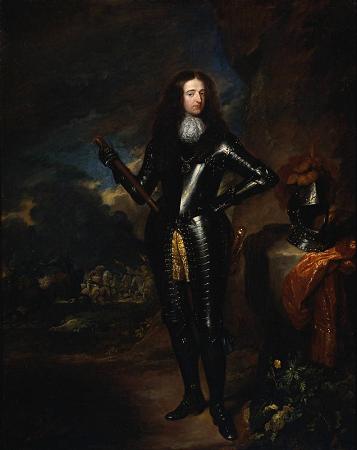Queen Anne (1665 - 1714). Anne was the Queen of England, Scotland and Ireland between 8 March 1702 and 1 May 1707. On 1 May 1707, under the Acts of Union, the kingdoms of England and Scotland united as a single sovereign state known as Great Britain. She continued to reign as Queen of Great Britain and Ireland until her death in 1714. Anne was born in the reign of Charles II to his younger brother and heir presumptive, James, whose suspected Roman Catholicism was unpopular in England. On Charles's instructions Anne and her elder sister, Mary, were raised as Anglicans. Mary married their Dutch Protestant cousin, William III of Orange, in 1677, and Anne married Prince George of Denmark in 1683. On Charles's death in 1685, James succeeded to the throne, but just three years later he was deposed in the Glorious Revolution of 1688. Mary and William became joint monarchs. Although the sisters had been close, disagreements over Anne's finances, status and choice of acquaintances arose shortly after Mary's accession and they became estranged. William and Mary had no children. After Mary's death in 1694, William reigned alone until his own death in 1702, when Anne succeeded him. During her reign, Anne favoured moderate Tory politicians, who were more likely to share her Anglican religious views than their opponents, the Whigs. The Whigs grew more powerful during the course of the War of the Spanish Succession, until 1710 when Anne dismissed many of them from office. Her close friendship with Sarah Churchill, Duchess of Marlborough, turned sour as the result of political differences. The Duchess took revenge with an unflattering description of the Queen in her memoirs, which was widely accepted by historians until Anne was re-assessed in the late 20th century. Anne was plagued by ill health throughout her life, and from her thirties, she grew increasingly ill and obese. Despite seventeen pregnancies by her husband, she died without surviving issue and was the last monarch of the House of Stuart. Under the Act of Settlement 1701, which excluded all Catholics, she was succeeded by her second cousin George I of the House of Hanover. Anne was born at 11:39 p.m. on 6 February 1665 at St James's Palace, London, the fourth child and second daughter of the Duke of York, and his first wife, Anne Hyde. Her father was the younger brother of King Charles II, who ruled the three kingdoms of England, Scotland and Ireland, and her mother was the daughter of Lord Chancellor Edward Hyde, 1st Earl of Clarendon. At her Anglican baptism in the Chapel Royal at St James's, her older sister, Mary, was one of her godparents, along with the Duchess of Monmouth and the Archbishop of Canterbury, Gilbert Sheldon. The Duke and Duchess of York had eight children, but Anne and Mary were the only ones to survive into adulthood. As a child, Anne suffered from an eye condition, which manifested as excessive watering known as defluxion. For medical treatment, she was sent to France, where she lived with her paternal grandmother, Henrietta Maria of France, at the Chateau de Colombes near Paris. Following her grandmother's death in 1669, Anne lived with an aunt, Henrietta Anne, Duchess of Orleans. On the sudden death of her aunt in 1670, Anne returned to England. Her mother died the following year. As was traditional in the royal family, Anne and her sister were brought up separated from their father in their own establishment at Richmond, London. On the instructions of Charles II, they were raised as Protestants. Placed in the care of Colonel Edward and Lady Frances Villiers, their education was focused on the teachings of the Anglican church. Henry Compton, Bishop of London, was appointed as Anne's preceptor. Around 1671, Anne first made the acquaintance of Sarah Jennings, who later became her close friend and one of her most influential advisors. Jennings married John Churchill in about 1678. His sister, Arabella Churchill, was the Duke of York's mistress, and he was to be Anne's most important general. In 1673, the Duke of York's conversion to Catholicism became public, and he married a Catholic princess, Mary of Modena, who was only six and a half years older than Anne. Charles II had no legitimate children, and so the Duke of York was next in the line of succession, followed by his two surviving daughters from his first marriage, Mary and Anne, as long as he had no son. Over the next ten years, the new Duchess of York had ten children, but all were either stillborn or died in infancy, leaving Mary and Anne second and third in the line of succession after their father.
more...





